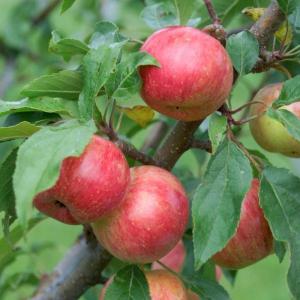Chestnut crabapples make wonderful cider and brandy
Bite into a bitter, sour crabapple and you might indeed think you are poisoned. The crabapple is one of the nine plants in the pagan Anglo-Saxon Nine Herbs Charm, used to treat poisoning and infections.
Reciting the charm mentions the major Germanic god Woden, where we get the word for our day of the week Wednesday, “Woden’s day.”
While many crabapples are sour and tart, some are sweet enough to eat out of hand. The Chestnut crabapple cultivar has larger fruit than most crabapples, and the coarse yellow flesh is extremely sweet. Tasters often notice hints of pear, honey, orange and even vanilla. The perfectly formed two-inch apples are perfect for kids’ lunches. The tiny apples ripen in September with light yellow skin blushed with orange-red. Tiny, light white spots give the skin a shimmering effect. It bears large crops every year, and is hardy, developed at the University of Minnesota in 1946. Like many crabapples, Chestnut crabapple makes wonderful cider and brandy.
Crabapples are probably best known as decorative trees, and the Chestnut crab puts on quite the show every May with huge clouds of white blooms. These pollen-rich flowers are useful to cross-pollinate other apple varieties. The Chestnut crabapple is an excellent natural source of pectin, so it is no surprise that it makes a tasty apple jelly.
Dead branches and even small limbs you prune from Chestnut crabapple are valuable firewood. Apple wood is an aromatic firewood that burns hot and slow. It lends a sweet flavor to smoked meats. Because it hardens as it ages, it is easiest to to cut apple wood when it is still green.
The crabapple is a wonderful multi-purpose tree. Lovely in the landscape, most of our varieties provide tasty, tart apples that are prized for making jelly.
Fall is the best time to plant trees, because they will form good root systems before bursting into growth in the spring. To plant your Chestnut crabapple, choose a sunny spot with good drainage. If your tree is bare root, soak the roots in a bucket of fresh water for 24 hours. Dig a hole twice as wide as and just a little shallower than the root ball. Never plant trees too deep, or the roots won’t be able to absorb enough oxygen for good growth. Rough up the sides of the planting hole so the root tips can easily penetrate. Tamp down the soil and water well to settle the soil and avoid any air pockets.
If you have average soil you do not need to fertilize your Chestnut crabapple trees at all.
It is a good idea to to mulch newly planted crabapple trees with a three-inch layer of organic compost or composted manure each spring. As this mulch breaks down, it will slowly fertilize the tree. Keep the mulch from touching the tree itself.
Chestnut crabapple trees can be ordered through local nurseries or by mail from specialty nurseries such as Stark Brothers (800-325-4180).
Plant a sweet Chestnut crabapple this fall and you will have white flowers perfuming your yard in a few years. The Chestnut crabapples will be miniature treasures to eat out of hand, and perhaps with the German god Woden’s help will treat poisonings and infections, especially, one imagines, if it is on Woden’s day, Wednesday.




















































